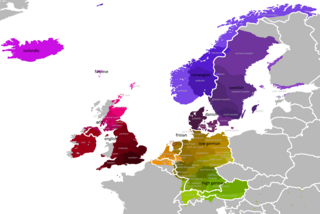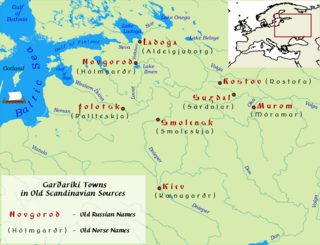Related Research Articles

The Germanic languages are a branch of the Indo-European language family spoken natively by a population of about 515 million people mainly in Europe, North America, Oceania and Southern Africa. The most widely spoken Germanic language, English, is also the world's most widely spoken language with an estimated 2 billion speakers. All Germanic languages are derived from Proto-Germanic, spoken in Iron Age Scandinavia and Germany.

Proto-Germanic is the reconstructed proto-language of the Germanic branch of the Indo-European languages.
In Germanic paganism, a seeress is a woman said to have the ability to foretell future events and perform sorcery. They are also referred to with many other names meaning "prophetess", "staff bearer", "wise woman" and "sorceress", and they are frequently called witches or priestesses both in early sources and in modern scholarship. In Norse mythology the seeress is usually referred to as völva or vala.

Aurvandill is a figure in Germanic mythology. In Norse mythology, the god Thor tosses Aurvandill's toe – which had frozen while the thunder god was carrying him in a basket across the Élivágar rivers – into the sky to form a star called Aurvandils-tá. In wider medieval Germanic-speaking cultures, he was known as Ēarendel in Old English, Aurendil in Old High German, Auriwandalo in Lombardic, and possibly as auzandil in Gothic. An Old Danish Latinized version, Horwendillus (Ørvendil), is also the name given to the father of Amlethus (Amleth) in Saxo Grammaticus' Gesta Danorum. Comparative studies of the various myths where the figure is involved have led scholars to reconstruct a Common Germanic mythical figure named *Auza-wandilaz, which seems to have personified the 'rising light' of the morning, possibly the Morning Star (Venus). However, the German and – to a lesser extent – the Old Danish evidence remain difficult to interpret in this model.

Garðaríki or Garðaveldi was the Old Norse term used in the Middle Ages for the lands of Rus'. According to Göngu-Hrólfs saga, the name Hólmgarðaríki was synonymous with Garðaríki, and these names were used interchangeably in several other Old Norse stories.

Frankish, also known as Old Franconian or Old Frankish, was the West Germanic language spoken by the Franks from the 5th to 9th century.

In historical linguistics, the High German consonant shift or second Germanic consonant shift is a phonological development that took place in the southern parts of the West Germanic dialect continuum in several phases. It probably began between the 3rd and 5th centuries and was almost complete before the earliest written records in High German were produced in the 8th century. From Proto-Germanic, the resulting language, Old High German, can be neatly contrasted with the other continental West Germanic languages, which for the most part did not experience the shift, and with Old English, which remained unaffected.
Like many other languages, English has wide variation in pronunciation, both historically and from dialect to dialect. In general, however, the regional dialects of English share a largely similar phonological system. Among other things, most dialects have vowel reduction in unstressed syllables and a complex set of phonological features that distinguish fortis and lenis consonants.
French is a Romance language that specifically is classified under the Gallo-Romance languages.
In historical linguistics, phonological change is any sound change that alters the distribution of phonemes in a language. In other words, a language develops a new system of oppositions among its phonemes. Old contrasts may disappear, new ones may emerge, or they may simply be rearranged. Sound change may be an impetus for changes in the phonological structures of a language. One process of phonological change is rephonemicization, in which the distribution of phonemes changes by either addition of new phonemes or a reorganization of existing phonemes. Mergers and splits are types of rephonemicization and are discussed further below.
Holtzmann's law is a Proto-Germanic sound law originally noted by Adolf Holtzmann in 1838. It is also known by its traditional German name Verschärfung.
Numerous lexemes that are reconstructable for Proto-Slavic have been identified as borrowings from the languages of various tribes that Proto-Slavic speakers interacted with in either prehistoric times or during their expansion when they first appeared in history in the sixth century. Most of the loanwords come from Germanic languages, with other contributors being Iranian, Celtic, and Turkic. Slavic loanwords sparked numerous debates in the 20th century, some of which persist today.

*Fraujaz or *Frauwaz, feminine *Frawjōn is a Common Germanic honorific meaning "lord", "lady", especially of deities.
This article contains information about Illyrian vocabulary. No Illyrian texts survive, so sources for identifying Illyrian words have been identified by Hans Krahe as being of four kinds: inscriptions, glosses of Illyrian words in classical texts, names—including proper names, toponyms and river names—and Illyrian loanwords in other languages. The last category has proven particularly contentious. The names occur in sources that range over more than a millennium, including numismatic evidence, as well as posited original forms of placenames. Messapic, an ancient language of Apulia which was of Balkan provenance and is grouped in the 'Illyric branch' of the Indo-European family, does have an epigraphic corpus, and some words have been recorded by ancient authors. Messapic words and relevant etymologies are listed in Messapic language#Lexicon.
References
- Auguste Brachet, An Etymological Dictionary of the French Language: Third Edition
- Auguste Scheler, "Dictionnaire d'étymologie française d'après les résultats de la science moderne" (in French)
- Centre National de Ressources Textuelles et Lexicales (in French)
- Dictionary.com
- Friedrich Diez, "An Etymological Dictionary of the Romance Languages"
- Dossier des Latinistes, La Greffe Germanique (in French)
- Thomason, Sarah Grey; Kaufman, Terrence (1991) [1988]. Language Contact, Creolization, and Genetic Linguistics (1st pbk. print. ed.). Berkeley: University of California Press. ISBN 978-0-520-07893-2.